Community Profile: Du Quoin Strives To Diversify Beyond State Fair
Photo Gallery | Article
Photo Gallery - De Quoin/Perry County, Ill.

Banners on lampposts in Du Quoin are a constant reminder of the city's claim to fame: the harness racing at the state fair. Photo by Susan C. Thomson
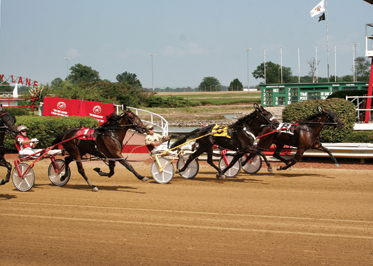
The Du Quoin State Fair has long been associated with harness racing. Despite the reputation, the races were held last year only on three days instead of the usual five because of declining popularity. Photo © Terry Jones

As at any major county or state fair, the exhibition of livestock remains a centerpiece of the action. Photo © John Croessmann, Du Quoin Evening Call
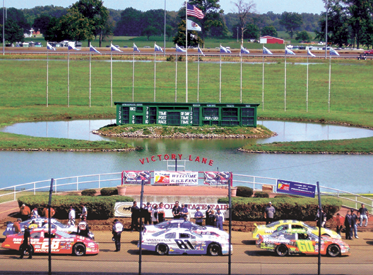
Car races are popular at the fairgrounds, too. Photo © John Croessmann, Du Quoin Evening Call
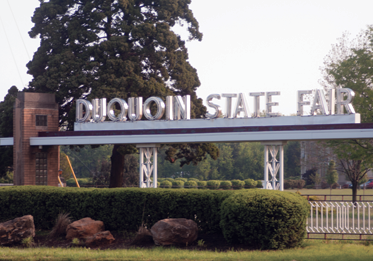
The state fair has lost money every year for at least a decade. To make up the slack, fair managers are trying to lure other activities to the extensive fairgrounds for the other 355 days of the year. So far, the grounds have been used for RV rallies, rodeos, monster truck shows, flea markets, demo derbies and even weddings. Photo by Susan C. Thomson
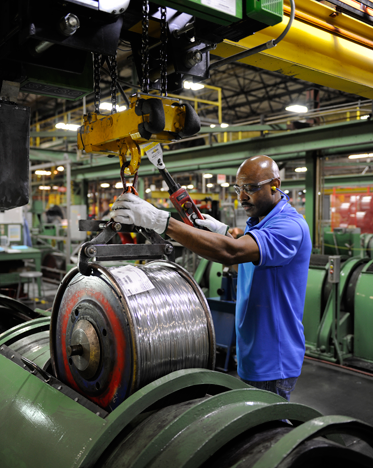
Wendell Killian at work at General Cable Corp., the largest employer in Du Quoin. The plant has thrived in town for more than 40 years, thanks to good labor-management relations and the resulting flexibility to quickly change product lines, says the human resources manager. Photo © General Cable Corp.
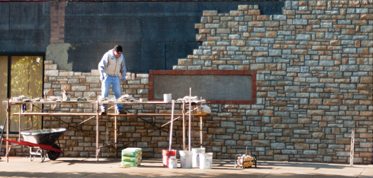
The Medicine Shoppe pharmacy is one of several downtown businesses that have taken advantage of $5,000 grants for updating their facades. The money became available through a tax-increment financing (TIF) district. Photo by Susan C. Thomson
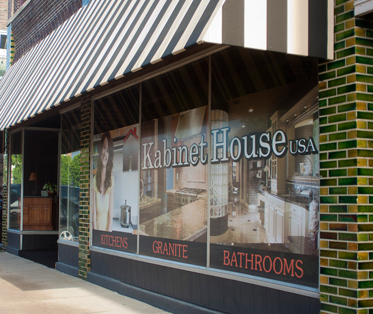
The Kabinet House has also taken advantage of grants for upgrading the fronts of buildings downtown. The money was raised through TIF (tax increment financing). Photo by Susan C. Thomson
Lamppost banners around town bear the old-time image of a horse-drawn, two-wheeled cart with a seated, mustached driver. Thus does Du Quoin, Ill., hitch its own wagon to its namesake event, the Du Quoin State Fair, long famed for harness racing.
The fair is the social, recreational and economic event of the year, unfolding over 10 days in late summer and peaking on Labor Day. It's a something-for-everyone affair, with auto and motorcycle races, horse shows, livestock and farm equipment exhibits, carnival rides, musical acts and food. Of course, there's also harness racing, though the schedule was reduced to three days from five last year, reflecting the sport's waning popularity, says the fair's manager, John Rednour Jr.
Attractions are spread out across the fair's 1,435 acres and its 77 buildings. The centerpiece is a 7,700-seat grandstand that looks out on a stage and the one-mile, lighted, circular racing track.
An estimated 350 temporary jobs make the fair briefly the city's largest employer. Upward of 300,000 people attend.
Local hotels are booked solid weeks in advance, with the overflow spilling out for miles around, says Stacy Hirsch, executive director of the Chamber of Commerce in Du Quoin (pronounced du-COIN). The fair boosts business for restaurants, gas stations and stores, adds Judy Smid, president of the Du Quoin Tourism Commission and proprietor of a downtown gift shop. Certified public accountant Harold Emling says the merchants tell him they get about a month's worth of their revenue from the fair.
Typical of state fairs, the Du Quoin event celebrates agriculture, historically a foundation of Southern Illinois' economy, along with coal. Agriculture remains the Du Quoin area's economic base, says Jeffrey Ashauer, the city's economic development consultant. Prospering from recent high prices for their corn, wheat and soybeans, farmers "come to town, buy new vehicles, put their money in the bank and go to Wal-Mart," he says.
Coal, meanwhile, has taken its lumps since the Clean Air Act dried up markets for the state's high-sulfur product. Most of the Du Quoin area's coal mines were shut down 20 or more years ago, and the resulting job losses account for Perry County's chronically above-average unemployment rate since, says Daniel Fulk, president of Du Quoin State Bank. The Great Recession? "Du Quoin has been in a statistical recession for the last 30 years," he says. "We're used to it." Through it all, the community has proved persevering and resilient, qualities that position it to "survive very nicely in the future," he adds.
Rex Duncan, one of the four members of the city's elected governing commission, also makes an upbeat case for the city, based on its brick-and-mortar assets. Showing a visitor around, he points out an Amtrak station with daily passenger service to Chicago and New Orleans, an $18 million high school under construction and a "basically new" hospital.
Marshall Browning Hospital dates to 1922, but it has been almost completely rebuilt over the past decade at a cost of nearly $10 million. Emergency room, radiology department, pharmacy, labs, surgical suites, offices, single-bed patient rooms—everything has been upgraded to state-of-the-art. A physicians' building and a 22-unit independent-living center have been added to the 19-acre campus on the edge of town.
The hospital has an annual payroll of $6.5 million and, between its 25 beds and extensive out-patient services, is able to meet 75 percent of the community's health-care needs, says the chief executive, William Huff.
"We don't have a lot of industry here," observes Emling, while acknowledging that two of the city's other leading employers happen to be manufacturers.
General Cable Corp. has been a fixture in town under various names and owners since 1965, making insulated cable, especially for electric utilities. The plant has thrived not only on good relations between management and the Teamsters-led labor force but also on the resulting flexibility to quickly change product lines, says human resources manager Kathy Hanks. Although 20 production jobs were cut during the recession, all have since been added back.
Heartland Baking, a commercial cookie maker that started up in 2006 in a bakery shuttered by its previous owner, is one of only two tenants in the city's 90-acre, 20-year-old industrial park. The other is MPP, an electroplating company that moved to the park from Kansas City in 2000.
Besides state tax credits linked to the number of jobs created, Heartland and MPP each got a low-interest $400,000 loan funded by the federal block grant program, with principal and interest repayable to the city. The city has used the income to make civic improvements and other low-interest business loans.
Ashauer says the park has proved a tough sell to out-of-town prospects for three reasons: U.S. manufacturing has been moving offshore, Illinois is perceived as business-unfriendly and Du Quoin isn't located on an interstate.
That "tough sell" has become a bit less tough now that the city has decided to outfit the park with solar panels. The installation, financed with $405,000 in federal stimulus money plus $135,000 in city development funds, is expected to be finished later this year. The panels are expected to shave electric bills for park tenants by 10 percent. Given that promise, word of the park is now spreading "like wildfire," Ashauer says.
As a further inducement, the city in 2009 classified the park and some nearby land as a tax-increment financing (TIF) district, where any new or increased city real estate taxes will be automatically reinvested.
This was the second of Du Quoin's two TIF zones. The original, set up two years earlier, covers the dozen square blocks of the city's Victorian-era downtown.
As the decades passed, Wal-Mart opened outside of downtown and retailers gravitated to malls. The city's core was showing signs of wear and neglect. "Your downtown is like your home; if you don't keep it up, it falls apart," says Mayor John Rednour Sr., father of the fair manager.
As one remedy, the city has set aside $100,000 from the downtown TIF and made it available in grants of up to $5,000 to downtown owners for updating their buildings' facades. Projects began this past spring. In the interest of creating synergies between downtown and the fair, TIF grants are also available to downtown businesses that make improvements designed to attract fairgoers. One of these went to a restaurant that added outdoor seating.
The fair has been a source of pride, fun and dollars to its hometown since its birth as a private enterprise in 1923. It has gone on uninterrupted, even through its 1986 takeover by the Illinois Department of Agriculture, which also runs the larger state fair every August in Springfield.
Independent audits, available from the state for the years through 2009, show the Du Quoin fair losing money annually for the previous decade on revenue averaging a little more than $1 million and expenses ranging from $1.5 million to more than $2 million.
But it's unfair to judge the fair on those numbers alone, officials say. For instance, while the audit shows a deficit of $863,288 for the 2000 fair, the festivities spun off more than $8 million in economic benefit to Perry County, according to an analysis by the University of Illinois and the Federal Reserve Bank of Chicago. A similar multiplier effect still applies, Rednour Jr. says.
Many fair events are free, and there is no general admission charge, just a parking fee. While striving to keep the fair "affordable for people to come with their kids and show them a good time," Rednour Jr. says he's also nudging it toward break-even by cutting some expenses and raising some fees.
Separately, fair managers several years ago began a drive to lure paying events in the year's remaining 50½ weeks. With their 1,200 electrically equipped campsites, the grounds have proved popular for RV rallies lasting a week or more. Other nonfair money-makers have included bull riding, rodeos, monster truck shows, charity events, weddings, picnics, flea markets, demo derbies, horse shows, auto races, motorcycle races and, of course, harness races. Annual revenue from off-season business has grown to between $650,000 and $700,000, officials say.
These extra events also boost the local economy, says Thomas Jennings, director of the Illinois Department of Agriculture. As for the fair proper, it's "a good deal for the community," he says. "The state supports all of the communities in Illinois. The fair is our opportunity to support Southern Illinois."
But for how long and how much? Until this year, the fair's future was never in doubt, Emling says. With the state of Illinois facing a deficit of more than $9 billion for fiscal 2012, all department budgets face cuts. And the fair, like every other expense, will "have to work its way through the legislature," Jennings says.
Du Quoin/Perry County, Ill., by the numbers
| POPULATION FOR CITY/COUNTY |
6,109/22,350 (1)
|
| LABOR FORCE |
NA/9,554 (2)
|
| UNEMPLOYMENT RATE |
NA/10.2 percent (2)
|
| PER CAPITA PERSONAL INCOME |
NA/$24,290 (3)
|
| (1) U.S. Bureau of the Census, 2010 census | |
| (2) BLS/HAVER, April 2011, seasonally adjusted | |
| (3) BEA/HAVER, 2009 | |
| Largest Employers | |
| General Cable Corp. |
215 (4)
|
| Heartland Baking LLC |
200 (5)
|
| Marshall Browning Hospital |
190 (4,6)
|
| Du Quoin Community Unit School District No. 300 |
187 (4)
|
| Wal-Mart |
110 (5)
|
| (4) Self-reported | |
| (5) Reference USAGOV, Infogroup Inc. | |
| (6) 150 full-time equivalents | |
Views expressed in Regional Economist are not necessarily those of the St. Louis Fed or Federal Reserve System.
For the latest insights from our economists and other St. Louis Fed experts, visit On the Economy and subscribe.
Email Us

